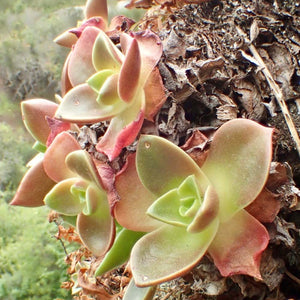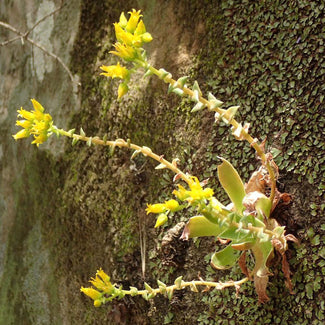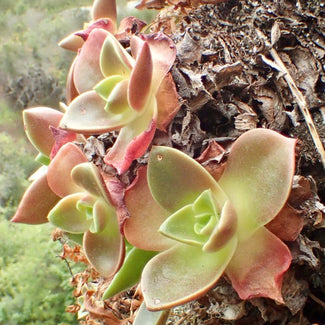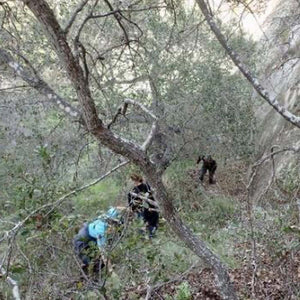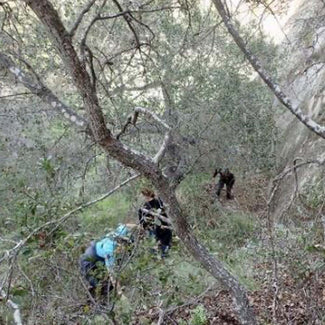|
 On December 12, 2022, I was contacted by Laura Cohen, the Natural Resource Specialist at Laguna Coast Wilderness Park, about plant losses at a colony of the rare Laguna Beach Dudleya (Dudleya stolonifera). On December 12, 2022, I was contacted by Laura Cohen, the Natural Resource Specialist at Laguna Coast Wilderness Park, about plant losses at a colony of the rare Laguna Beach Dudleya (Dudleya stolonifera).
Dudleya stolonifera is protected by both U.S. and CA Endangered Species laws as a Threatened species. It is Orange County’s only endemic plant species and also the logo of the Orange County Chapter of the California Native Plant Society (OCCNPS). Six colonies are known to exist, all in and around the city of Laguna Beach. The plant grows exclusively on a handful of shaded, vertical rock faces, either comprised of sandstone or a conglomerate rock known as San Onofre breccia. To protect the species, the locations of these colonies are secretive and generally not publicly known.
As the chair of Plant Science for OCCNPS and a member of the Rare Plant Committee, I regularly monitor each of these colonies. I last visited and documented this colony in May 2019, while assisting U.S. Fish and Wildlife with their Five-Year Review. These periodic reviews are extensive and are required as part of the recovery plan for all organisms protected under the Endangered Species Act. During my 2019 visit, I counted between 500-1,000 plants. A detailed CA Natural Diversity Database (CNDDB) Field Survey report was also filed with the CA Dept. of Fish & Wildlife (CDFW).
Upon being notified of possible plant losses at this colony, three days later I visited the site to assess the population. 155 living plants (larger than seedling stage) were counted, along with many additional dead and decaying plants. There were only a few young plants where I had noted and photographed mature plants in 2019. Images of the remaining dead and decaying plants were shown to Stephen McCabe, the foremost Dudleya expert and Fred Roberts, chair of the OCCNPS Rare Plant Committee.
The population at this site is greatly reduced. Most of the large mature plants, previously in the more accessible portion of the colony are gone. Of the dead plants remaining, their leafy top rosettes are mostly missing, with only their semi-woody decaying caudex bases remaining. But even these were only found on the lower, more accessible areas of the wall. Also concerning were a few pieces of debris and trash found within arm’s reach of the plants, including an empty plastic strawberry basket, something that Stephen McCabe suggested could be used for Dudleya poaching.
On Dec. 22, I returned to the site, this time with a large contingent, including biologists from OC Parks, CDFW, the CA Botanic Garden and the Chambers Group. Also included in the team were CDFW game wardens and OC Parks enforcement officers.
Is this loss of a rare and protected plant species the result of illegal live plant poaching or is it death from other causes? We cannot be certain, but we all agree, poaching is a reasonable possibility. This site is one of the most accessible locations for the species and it is well concealed from view. Other possible explanations for the loss are natural die-off from the extended drought, insect damage by a moth (suggested by Stephen McCabe; and if a moth, Bob Allen suspects that it would be the dudleya moth, Rhagea stigmella), or cold and frost.
As mentioned, I also monitor the other five known colonies of Dudleya stolonifera and during the past two to three years have not noted any similar losses, increasing the likelihood of poaching as the primary suspect here.
As the leading authority on local native plant status and distribution, OCCNPS botanist experts are a trusted resource for rare plant information. USFW, CDFW, OC Parks and OCCNPS will continue to monitor this population and others in the Laguna Beach area and will work collaboratively to ensure the effective conservation and management of this iconic Orange County native plant.
|







 On December 12, 2022, I was contacted by Laura Cohen, the Natural Resource Specialist at Laguna Coast Wilderness Park, about plant losses at a colony of the rare Laguna Beach Dudleya (Dudleya stolonifera).
On December 12, 2022, I was contacted by Laura Cohen, the Natural Resource Specialist at Laguna Coast Wilderness Park, about plant losses at a colony of the rare Laguna Beach Dudleya (Dudleya stolonifera). 
